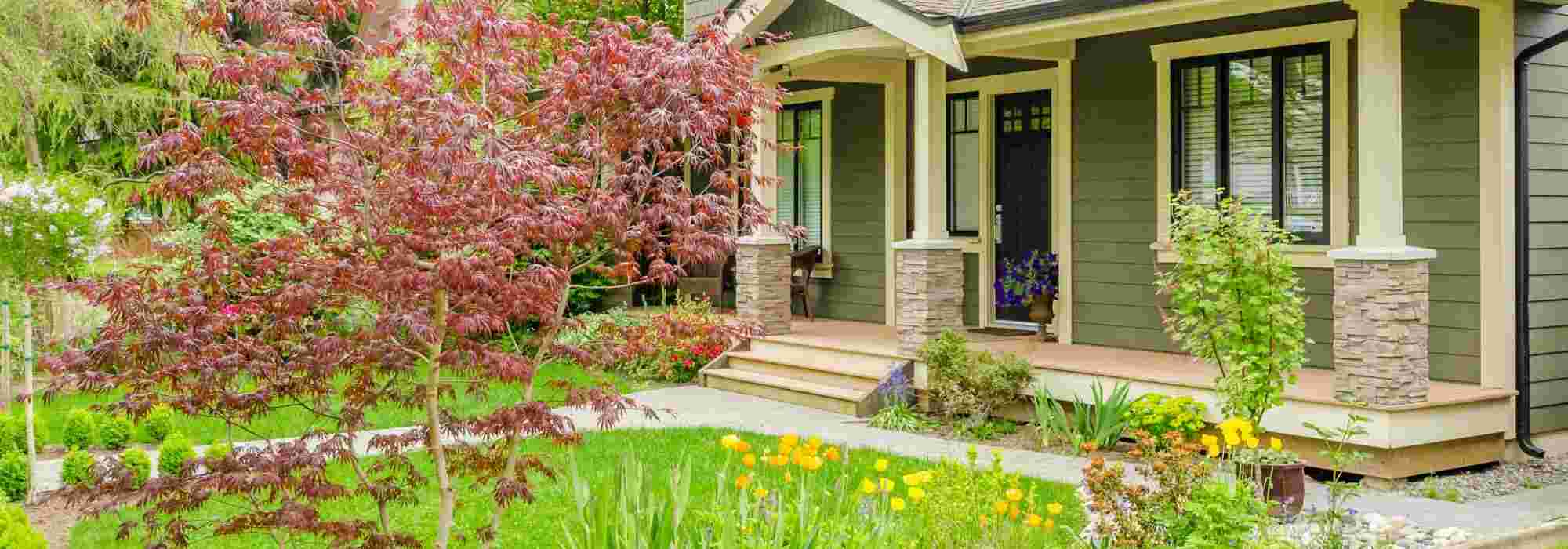
Designing a garden in front of a house
For a welcoming entrance
Contents
Small paved courtyard, wide planted paths, porch, steps, patch of garden… The front of the house takes many forms depending on its location on the plot. It is an important space that should reflect your tastes and suit the style of your home. Discover all our tips for an aesthetic and functional entrance!
Key point
It’s the first thing people see of your home and the space you’ll use daily. The front of the house is an essential area, laid out with care. Many homes have a garden at the front and another at the back. The front area therefore accommodates many uses: paths, a garage, an entrance terrace… The rear of the house, freed from these layout constraints, is more often used for leisure: relaxation, dining, play, rest… Although the front of the house is usually seen as a thoroughfare, it is perfectly possible to create seating areas there and to craft ambience with plant combinations.
Read also
Designing a small gardenMatch your garden to your home
You can choose to match garden to style of house, or to contrast the two! There are no predefined rules. However, certain garden styles are known to suit particular house types. Here are best-known pairings, to match… or not!
An old house
Old or period houses are characterised by noble materials and a certain rusticity. Walls and low stone walls, roofs of regional tiles, chimney… They have undeniable charm and an authenticity that delights many! These old farmhouses and other buildings often undergo renovation. Windows, large glazed openings and renders bring a little light into these sometimes dim ensembles. For the garden, take inspiration from our British neighbours! Their cottages, those little country houses, are enhanced by planting. Indeed, they create large mixed borders around them. These generous beds are made up of bushes, perennials and annuals. To create a true “cottage entrance”, start by installing a white picket fence. In front of it, create beds mixing bushes such as viburnums and honeysuckles with perennials like Perovskia and Rudbeckia. Add a few bulbs, such as dahlias and hyacinths, and you will obtain a beautiful flowering bed. A gravel path leading to the house will complete this country-style layout.
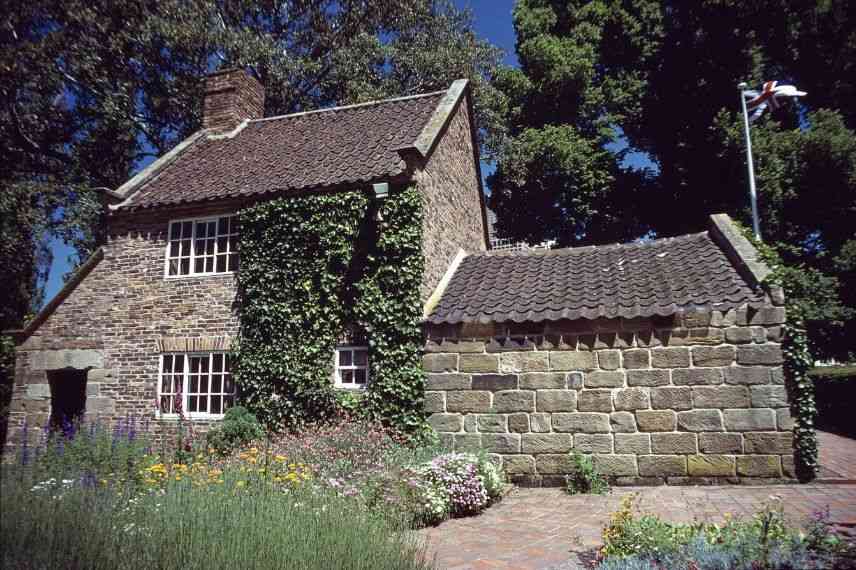
Provençal house
In France, Mas, bastide or villa, Provençal houses have plenty of character! They display facades of dry stone or coloured render. Yellow, orange, pink or red, colours are warm, reflecting the region! Weathered tiles with a patina and a first-floor balcony add charm to the whole. No doubt about it, Provençal houses are timeless examples of French architecture. How to arrange entrance of these houses? Many fine homes in the south have a grand entrance. Immense driveways are alternately lined with cypresses and pines from the gate to the front door. You can be inspired by this style to reproduce it on your scale. Lay a path in stabilised sand that leads to the door. This time, along the path, plant dwarf conifers if garden is small. Japanese red pine does not exceed 1.5 m, while Oriental Thuja adopts a conical habit reaching up to 1 m in height. Either side of the path, if you have some relief, opt for a rockery. It will dress the entrance without requiring much maintenance. For greater simplicity, think of groundcovers. As a replacement for lawn, they are ideal for creating a planting bed in dry climate. Azorella trifurcata is perfectly suited to poor, dry soils. It quickly forms cushions of green, adorned with small yellow-green flowers in summer.
Modern house
There are many varied architectures of modern houses. You will generally find smooth walls, clean lines, large openings and generous volumes. Sometimes the modern house has a flat roof where climate allows, otherwise slate tiles. Facades are mostly light and host large windows and glazed doors, favouring a light-filled interior. In the garden, play the design card by adopting a minimalist look and mixing materials. For example, opt for beds at the sides, a lawn and a path. Beds are stocked with box bushes clipped into balls, sometimes trained on stems, sometimes not. To add movement to this graphic look, Gaura and Stipa sway in the wind. A central path leads to the front door. It is made of concrete slats laid in a staggered pattern, ending in the short grass meadow. This should be well mown, creating a true green carpet. Modern and neat, this type of entrance immediately signals contemporary taste.
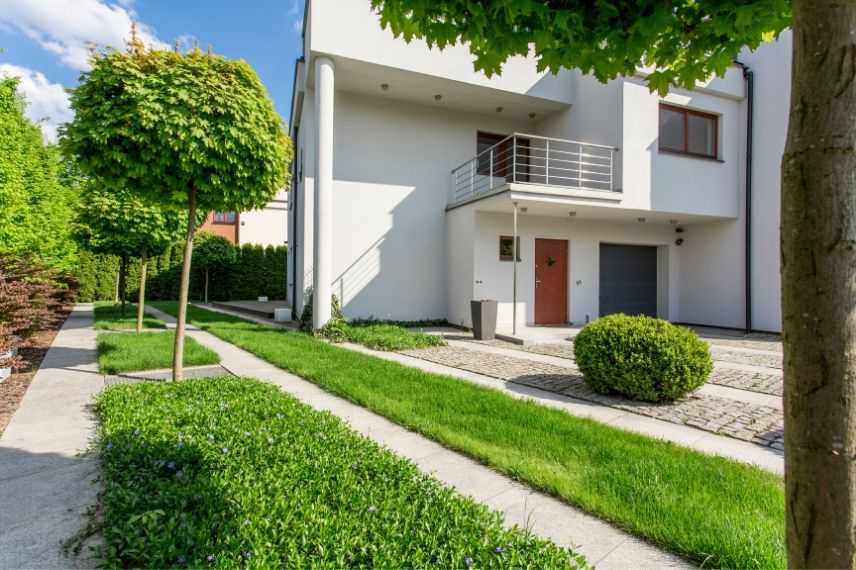
Classic / manor house
Multiple storeys, stone facades, ornate window surrounds, a high roof, wooden shutters and perhaps a small turret attached to the house. All these ingredients combine to form a manor house! Built between the 17th and 20th centuries, these bourgeois residences benefit from noble materials and high ceilings. They can be accompanied by large grounds when in the countryside, or by a very small garden in the city. How to enhance these manor-like homes? Play the game to the full, of course! For this, take inspiration from French formal gardens. To create a majestic entrance, install a fountain! At the centre of the garden, it enlivens the front of the house with its jets of water. This water feature is skirted on both sides by a stabilised sand path, like gardens of grand estates. Along it, topiary trees structure the route. They instantly adorn a garden with their geometric shapes. This type of pruning demands maintenance. To make it easier if you do it yourself, choose simple shapes such as balls or cones. Have it done the first time, then, if you are used to the shears, you can take over at the next pruning. The rest of the garden can simply be dressed with a lawn mown quite short, to perfect this elegant exterior, dressed to the nines. For fences and gates, wrought iron seems the material that best matches. However, aluminium, light and durable, is also a good option.
Wooden house
Warm and natural, the wooden house charms with its little chalet look. One easily imagines it by the edge of a pond or deep in a forest, at the heart of a green haven. Yet this type of construction is increasingly common, especially when it comes to eco-friendly houses. Nodes, veins and warm tones of wood make this material a benchmark in construction. In harmony with the house, garden should be natural and flexible. You can then sow a meadow! From spring to summer it is adorned with small wildflowers of all colours. If you are starting from a lawn, you can either dig it over or cover it with a tarpaulin so that the grass dies before sowing the meadow the following spring. Then break the clods of earth well and rake to obtain a smooth layer of soil. The hardest part is done! All that remains is to scatter seed in spring or autumn, then water with a fine spray. Once meadow established, it is easy! Only two mowings per year (spring and autumn) suffice to maintain it, with a scythe or a brushcutter. Be aware that there are flower meadows for shade, sun, poor soils, etc. For a most bucolic style, just mow a path to access the house.
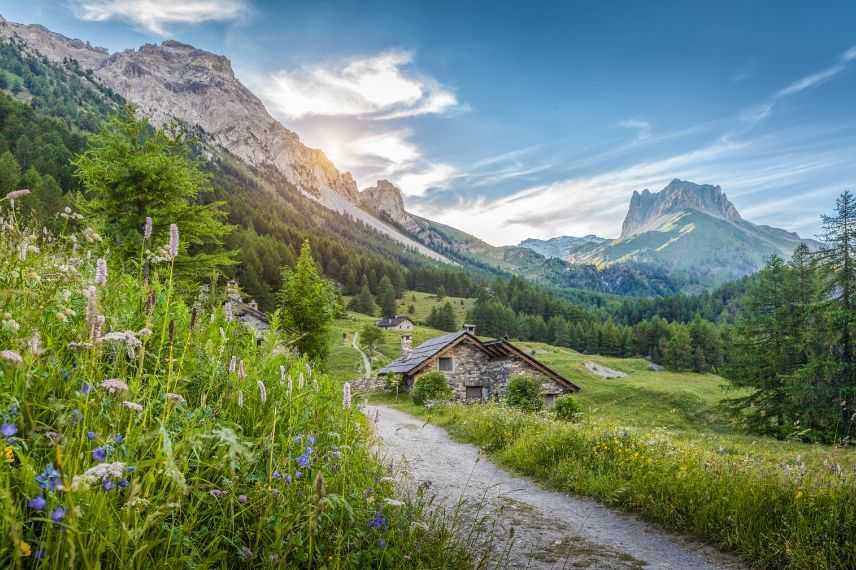
Structuring with evergreens
To avoid winter blues, choose evergreen species that stay attractive all year round! Moreover, this helps to structure garden and define spaces. For this, favour planting close to the front door a selection of ornamental evergreens. They dress the doorstep and offer a pretty view from inside. This is the case with Rosa banksiae ‘Lutea’, a liana rose. You can train it up the steps leading to the house, or onto a pergola surrounding the front door. Its double yellow flowers appear between April and June, as do most roses. However, this species has the advantage of being evergreen, as does the cultivar ‘Rosea’, whose flowering is pink. You can also plant beds of evergreen bushes! Unlike a hedge, their habit will be more natural; all that remains is to play with different heights. At back of the bed, a Virginia juniper offers silvery foliage and reaches 5 m high. A little lower, around 3 m high, Pseudopanax lessonii ‘Dark Star’ reveals purple foliage for contrast. At front of the bed, Choisya ‘Aztec Gold’ adds a touch of brightness with its slender golden leaves. Feel free to use species with coloured foliage to guide and brighten garden all year round.
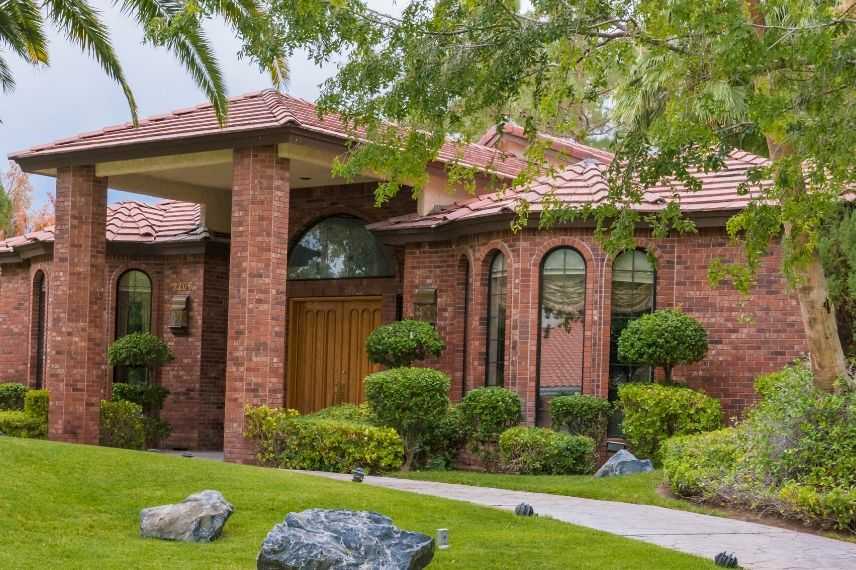
Evergreen bushes and topiaries structure space!
Read also
How to landscape a sloping garden?Providing privacy
The front of the house is often located along the street. A street you try to forget when in your garden. For this, a hedge and a fence are extremely effective. In addition to visually blocking the entrance, they act as sound insulation and prevent any intruder from entering the property. To be truly secluded, it is better to install a boundary fence first; this will give you more choice for bushes to plant afterwards. Indeed, without a fence you will be obliged to resort to evergreen and compact essential oils. Wood panels have a modern, natural look but will require some maintenance. Allow for one coat of stain per year. If you do not want to maintain the fence, prefer aluminium, available in many colours. Along the fence, you can then plant a hedge. Several options are available to you :
- A low hedge with dwarf varieties of Abelia, Berberis, Camellia, Deutzia, euonymus and Potentilla
- A fruiting hedge with raspberries, goji, currants and hazel
- A flowering hedge with amelanchier, hawthorn, butterfly bush, Calycanthus and quince trees
- A “thorny” hedge with Berberis, holly, Mahonia, Pyracantha and Poncirus trifoliata
This way, you can really spend time in this space once well secluded. This layout is ideal for making the most of a small garden and not seeing the front area merely as a thoroughfare.
Functional space
Entrance path
It’s the trump card of the entrance, the path you take to go to work, to drop the children off here and there… Material will change depending on whether you use it by car or only on foot. For a pedestrian path, you can blur its edges and create unity by fitting it in wood, for example as an extension of a terrace. To suit a traditional house, why not stone slabs with grassed joints? If you want a driveable path, cobbles will pair well with an older house, whereas concrete is ideal for a contemporary style. Whatever material chosen, remember to emphasise this path with borders. Well-pruned rosemary, box or honeysuckle will define the different entrances.
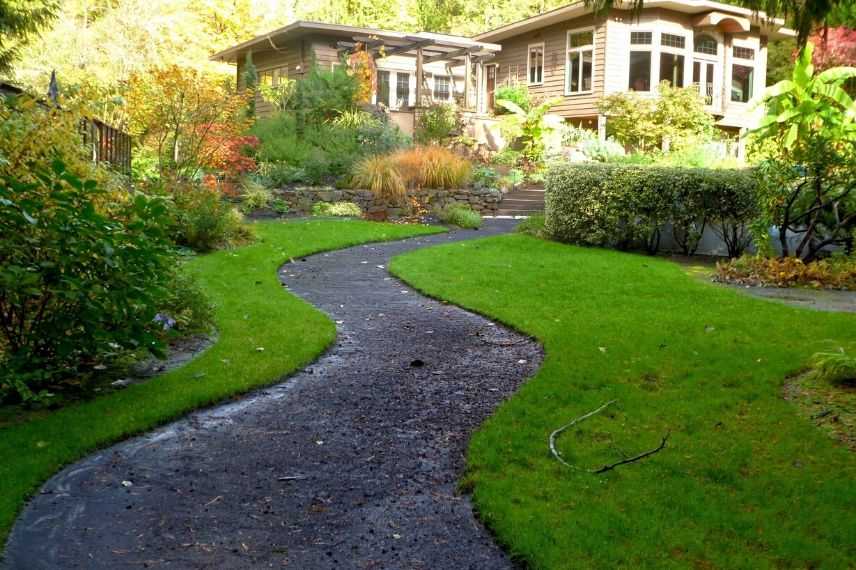
Car park
It’s not the most attractive feature of a garden, yet you must account for it! Either you have an integral garage and all that remains is to create a driveable path, or you have no garage and need to find a parking space for the car. To keep it as discreet as possible, place it under a carport to protect it from the elements. Around this feature, don’t hesitate to plant! One variety of bamboo is particularly suitable: Fargesia murielae ‘Jumbo’. This essential oil is non-running, that is to say it is not invasive. Reaching 3 m in height, its compact silhouette will conceal the parking area while bringing a zen touch!
Opt for container planting
Is the front of your house mineral? Prefer to keep the back of the house for planting beds? No problem! You can absolutely rely on potted plants to dress your entrance while keeping practical aspect of a mineral surface. The advantage of pots is that they can be placed and moved easily. To avoid obstructing your way, position them close to your front door. This way they highlight the door, the doorstep, the terrace or the steps of your home. Small trees placed on either side of the door frame the entrance and decorate arrival at the house. If you are in shade, Japanese maples, with their elegant silhouettes, are well suited to the job. Their coppery tones in autumn make them even more attractive. In sun? Pinus nigra ‘Pierrick Brégeon’ offers a beautiful crown of needles. This black pine does not exceed 1.5 m and does well in a pot. If you have a staircase, dress it with climbing plants! Place a planter at its base and wind the stems around the balustra. With its bell-shaped flowers in spring, Akebia reaches 6 m in length, enough to dress flights of steps! Think also of wisteria and their showers of purple clusters in May. However, the balustra material must be sturdy enough to withstand the knotty branches of this climbing plant!
- Subscribe!
- Contents































Comments